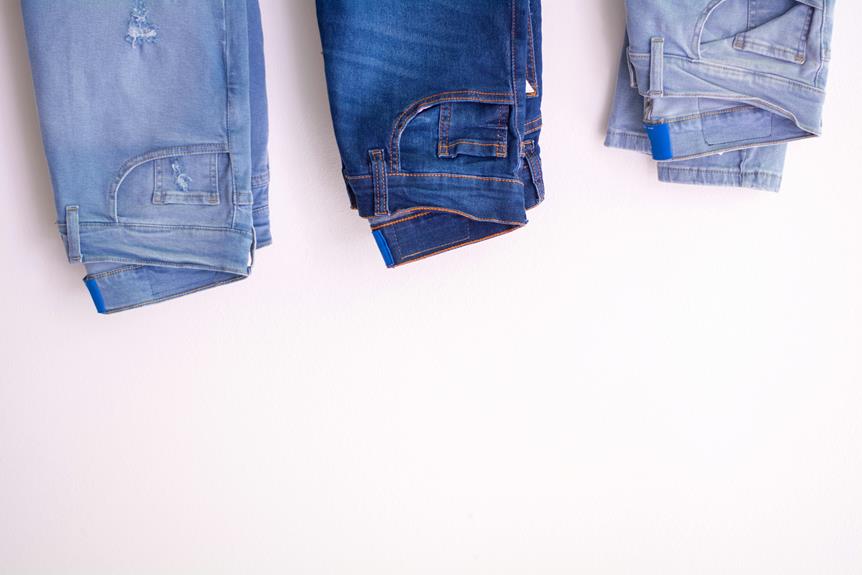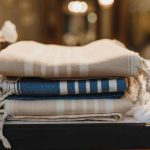You're likely familiar with French Terry fabric as a popular choice for loungewear and casual clothing, but have you ever considered using it for outdoor activities? As an outdoor enthusiast, you know that the right fabric can make all the difference in performance and comfort. French Terry's moisture-wicking abilities, breathability, and lightweight construction make it an attractive option for outdoor clothing. But can it withstand the rigors of outdoor activities? Its limitations, such as pilling and snagging, raise concerns about durability. Let's take a closer look at whether French Terry can truly hold up to the demands of outdoor adventures.
Table of Contents
Benefits of French Terry Fabric
Your outdoor gear gets a performance boost from French Terry fabric's unique blend of characteristics, including moisture-wicking abilities, breathability, and lightweight construction.
This fabric is designed to keep you dry and comfortable, making it an excellent choice for outdoor enthusiasts.
When you're hiking, biking, or engaging in other high-intensity activities, French Terry fabric helps regulate your body temperature, preventing overheating and discomfort.
You'll appreciate the fabric's ability to wick away moisture, allowing you to stay dry even during intense physical activity.
Additionally, French Terry fabric is breathable, which means it allows for airflow and helps prevent the buildup of sweat. This feature is especially important for outdoor enthusiasts who need to stay cool and dry in warm weather conditions.
The lightweight construction of French Terry fabric also makes it an excellent choice for outdoor gear, as it won't weigh you down or restrict your movement. Overall, French Terry fabric's unique blend of characteristics makes it an excellent choice for outdoor enthusiasts who demand high-performance gear.
Outdoor Activities and Fabric Needs
When you're planning outdoor activities like hiking, biking, or kayaking, it's essential to consider the specific fabric needs for each pursuit to ensure you're getting the most out of your gear. Different activities require different fabric properties, such as breathability, moisture-wicking, and insulation.
| Activity | Key Fabric Needs | Why It Matters |
|---|---|---|
| Hiking | Breathability, moisture-wicking | Regulates body temperature and prevents overheating |
| Biking | Stretchiness, wind resistance | Allows for a full range of motion and reduces wind chill |
| Kayaking | Water resistance, quick-drying | Keeps you dry and comfortable in wet conditions |
As you can see, each activity has unique demands on the fabric. By understanding these needs, you can choose the right fabric for your outdoor gear. For example, if you're a hiker, you'll want a fabric that breathes well and wicks away moisture to keep you cool and dry. By selecting the right fabric, you'll be able to perform at your best and enjoy your outdoor activities more. This understanding is crucial when considering whether French terry can be used for outdoor clothing.
French Terry's Durability Concerns
When you're considering French Terry for outdoor clothing, you'll want to examine its durability concerns.
You'll need to think about how well the fabric will hold up to wear and tear, as well as its ability to resist abrasion and withstand various weather conditions.
Fabric Wear and Tear
French terry's softness and breathability come at a cost, as it's more prone to pilling and snagging than other fabrics, which can significantly shorten its lifespan in outdoor clothing.
You'll notice that French terry fabrics tend to lose their texture and appearance over time, especially when subjected to repeated wear and tear. This is because the fabric's loops can easily break or become distorted, leading to a rougher, less comfortable texture.
When you're using French terry for outdoor clothing, you'll want to consider the activities you'll be doing and how they'll impact the fabric. For example, if you'll be hiking or backpacking, the fabric may be more prone to snagging on branches or rough surfaces.
Additionally, French terry's tendency to pill can make it look worn out faster, which may not be ideal for outdoor enthusiasts who want their gear to look good for a long time. By understanding these limitations, you can make informed decisions about whether French terry is the right choice for your outdoor clothing needs.
Abrasion Resistance Issues
Considering the inherent softness of French terry, you may assume it can withstand gentle friction, but it actually performs poorly in abrasion resistance tests, which is a significant durability concern for outdoor clothing.
When subjected to repeated rubbing or scraping, French terry's loops can easily break or snag, leading to a rough, frayed appearance.
This can be particularly problematic for outdoor enthusiasts who need clothing that can withstand rough terrain, branches, or other environmental stressors.
You may wonder why French terry struggles with abrasion resistance.
The answer lies in its unique construction. French terry's loops are created by a specific weaving process that leaves the fabric vulnerable to snagging and pilling.
While this construction makes French terry soft and comfortable against the skin, it also compromises its durability.
As a result, you may find that French terry clothing shows signs of wear and tear more quickly than other fabrics, particularly in high-friction areas like the elbows, knees, or hemlines.
This can be a major concern for outdoor enthusiasts who need clothing that can keep up with their active lifestyle.
Weathering Performance Concerns
While abrasion resistance issues can be a major concern for outdoor enthusiasts, it's also important to consider how well French terry clothing holds up against the elements, particularly when it comes to weathering performance.
As you expose French terry clothing to wind, rain, snow, and sunlight, it may not be able to withstand these harsh conditions. One major concern is its susceptibility to fading and discoloration due to UV radiation, which can significantly reduce the lifespan of your gear.
If you're planning to wear French terry clothing outdoors frequently, it's crucial to weigh these factors and assess your priorities.
French terry fabrics often possess moisture-wicking properties and quick drying times, making them an attractive choice for casual outdoor activities in moderate conditions.
By evaluating the activity's level of intensity and duration, as well as your clothing needs, you'll be better equipped to determine if French terry clothing meets your standards.
For rigorous or long-duration activities in extreme conditions, more weather-resistant options may still be preferred, while more casual or everyday outings could suit French terry better.
Weave and Thickness Considerations
When considering French Terry for your outdoor clothing, you'll want to examine the weave and thickness to ensure they meet your performance needs.
You'll find that the density of the weave matters, as it affects the fabric's ability to breathe, insulate, and resist wind.
Weave Density Matters
A denser weave will provide better protection against the elements, while a looser weave may compromise the fabric's ability to withstand wind, rain, and sun exposure.
When evaluating the weave density of your French terry fabric, consider the thread count. A higher thread count typically indicates a denser weave, which can improve the fabric's durability and resistance to pilling.
Yarn weight is also an important factor, as thicker yarns can create a denser weave, but may also affect the fabric's breathability and flexibility.
The weave pattern is another consideration, as a twill or satin weave can provide a denser fabric than a plain weave, but may also impact the fabric's texture and appearance.
Lastly, fabric weight is also a key factor, as a heavier fabric weight often corresponds to a denser weave, but may also affect the garment's overall weight and mobility.
Thickness Affects Performance
Consider the thickness of your French terry fabric, as it significantly impacts the garment's performance, breathability, and overall comfort in outdoor clothing. You'll want to choose a thickness that balances warmth and mobility.
A thicker fabric will provide more insulation, but may feel stiff and restrictive. On the other hand, a thinner fabric will allow for greater flexibility, but may not retain enough heat.
When selecting a French terry fabric for outdoor clothing, you should consider the intended activity level and climate. For example, if you're planning to wear the garment for high-intensity activities in cold weather, a mid-weight fabric (around 12-14 oz) may be suitable.
This thickness will provide enough warmth without feeling too bulky. For milder climates or low-intensity activities, a lighter fabric (around 8-10 oz) may be more suitable.
Weight and Durability
Pairing the right weave density with the ideal thickness is crucial to achieve the perfect balance of weight and durability in French terry outdoor clothing, as a fabric that's too loose can compromise its performance, while one that's too dense can be overly heavy.
When you're choosing a French terry fabric for outdoor clothing, you need to consider the intended use and the activities you'll be doing. If you'll be engaging in high-intensity activities or need a fabric that can withstand harsh weather conditions, a denser weave may be necessary.
However, if you prioritize comfort and mobility, a looser weave may be more suitable.
- Fabric weight: Lighter fabrics (around 200-250 g/m²) are ideal for warm weather or low-intensity activities, while heavier fabrics (around 350-400 g/m²) are better suited for colder weather or high-intensity activities.
- Thread count: A higher thread count typically indicates a denser weave, which can improve durability but may also increase weight.
- Weave density: A tighter weave can provide better wind and water resistance, but may also reduce breathability.
Moisture Management and Breathability
French terry fabric is known for its unique properties that facilitate efficient moisture management and breathability, keeping you dry and comfortable in various outdoor activities.
When you're engaging in high-intensity activities like hiking or biking, you'll appreciate how French terry fabric wicks away moisture from your skin, allowing it to evaporate quickly. This helps prevent the buildup of sweat, which can make you feel clammy and uncomfortable.
As you move, the fabric's breathability allows for airflow, which helps to regulate your body temperature. This means you'll stay cooler in warm weather and warmer in cool weather.
Additionally, French terry fabric's moisture-wicking properties help to prevent the growth of bacteria and odor-causing microorganisms. This is especially important for outdoor enthusiasts who may not have access to laundry facilities for extended periods.
French Terry's Temperature Range
Outdoor activities like backpacking, camping, and trail running often involve a range of temperatures, but terry's natural fibers help you adapt, from warm days at lower elevations to cooler nights in the mountains. As you hike, the temperature can fluctuate greatly, and it's essential to wear clothing that can keep up.
French terry's temperature range is surprisingly versatile, making it an excellent choice for outdoor enthusiasts.
You'll find that French terry excels in mild to moderate temperatures, typically between 40°F to 70°F (4°C to 21°C). This range allows you to wear French terry clothing during spring and fall hiking trips, mild winter days, cooler summer mornings and evenings, and high-intensity activities in cooler temperatures.
When you're active outdoors, your body temperature can rise quickly. French terry's moisture-wicking properties help regulate your body temperature, keeping you cool when it's warm and warm when it's cool.
While French terry may not be the best choice for extreme temperatures, it's an excellent option for outdoor activities that involve varying temperatures. By wearing French terry clothing, you'll stay comfortable and focused on your adventure.
Practical Applications and Examples
When you're gearing up for your next adventure, consider how French terry's temperature range and moisture-wicking properties can be put to practical use in your clothing choices.
You can wear French terry tops and leggings as a base layer for colder outdoor activities like hiking or skiing. The fabric's breathability will help regulate your body temperature, keeping you warm and dry.
For warmer weather, French terry can be used as a lightweight, quick-drying outer layer for activities like running or biking.
You can also use French terry to make outdoor accessories like hats, scarves, and headbands. These items can add a layer of warmth and protection from the elements without weighing you down.
Additionally, French terry's moisture-wicking properties make it an excellent choice for outdoor clothing that needs to withstand repeated washing and wear. Consider using French terry for outdoor clothing items that require durability and performance, such as camping shirts or hiking pants.
Frequently Asked Questions
Can French Terry Be Used for Outdoor Gear Like Backpacks?
You might be considering using French Terry for outdoor gear like backpacks. It's essential to evaluate the fabric's properties and compare them to your gear's requirements to decide if French Terry meets your outdoor gear needs effectively.
Is French Terry Suitable for Outdoor Activities in Extreme Weather?
You're wondering if French terry's suitable for outdoor activities in extreme weather. It's generally not the best choice for harsh conditions, as it can be heavy when wet and lacks breathability, which might hinder performance.
How Does French Terry Compare to Other Outdoor Fabrics Like Fleece?
You're considering French Terry for outdoor gear, but how does it stack up against fleece? French Terry's softness and breathability are great, but fleece generally offers better insulation and warmth in harsh weather conditions, don't you think?
Can French Terry Be Treated With Waterproof or Water-Resistant Coatings?
You're considering treating French terry with waterproof or water-resistant coatings. This process can enhance its durability and functionality. Look for specialized treatments like Gore-Tex or similar technologies to improve the fabric's performance.
Is French Terry a Good Choice for Outdoor Clothing for Children?
You're considering French terry for outdoor kids' clothing, but it's essential to weigh the pros and cons. French terry is soft, breathable, and absorbent, but it may not provide the necessary durability or water resistance for outdoor activities.
- How Does Ring Spun Cotton Affect Garment Fit and Shape Retention? - August 13, 2024
- What Are the Challenges in Producing Ring Spun Cotton? - August 13, 2024
- Is Ring Spun Cotton Suitable for Plus-Size Clothing? - August 13, 2024






